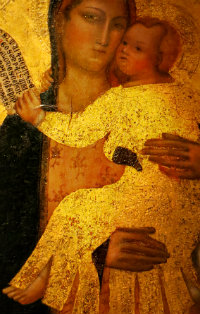Search:: Artists Alphabetically Artists by Country Artists by Century Artists by Movement
Painting in the Middle Ages550 -1450
The Age Of Faith

Art
of the Middle Ages, 550-1450, was complex and intriguing, fraught with
religious fervor and symbolism. The Catholic Church, the all powerful
institution of the time, commissioned Biblically themed art-works such
as paintings, sculptures, architecture and illuminated manuscripts.
Stories of the Bible were told and retold continuously--painted,
sermonized, allegorized, embellished, creating a convincing and
mysterious faith.
In
a society of limited literacy, constant outbreaks of black death,
smallpox, leprosy, and the ever present threat of famine, art was a
true sanctuary. Paintings were darkly mystical, infused with an
ethereal emotional intensity. The mysticism of the Middle Ages imparts
a sense of uniqueness and wonder to art. Painters from this time period
had a taste for the poetic and their use of symbols are secretive hints
and glances into the mysterious religious world that lies behind the
dark reality of the times. As time went on the style of painting was a
reflection of the transformation that was taking place in Europe, the
change from the feudal system to a more enlightened society.
Manuscript
illumination offers some of the greatest examples of Biblically themed
paintings. These early masterworks were created in monasteries by pious
monks. The room in the monastery where illuminators worked was called a
scriptorium. According to Medieval historian John William Bradley, "In
the sixth century the monasteries, such as they were, necessarily kept
themselves very quiet and unobtrusive. They were situated usually in
out-of-the-way corners, solitudes apart from civilization, or, at
least, apart from the busy haunts of men. "
According to art historian Clara Erskine
Clement "The Middle Ages extend from the latter part of the
fifth century to the time of the Renaissance, or about the fifteenth
century. The painting of this period has little to attract attention if
regarded only from an artistic stand-point, for we may truly say that,
comparing it with the Greek art which had preceded it, or with the
Italian art which followed it, that of the Middle Ages had no claim to
the beautiful. On the other hand, it is full of interest to students,
because it has its part in the history of art; therefore I shall give a
mere outline of it, so that this link in the chain which unites ancient
and modern painting may not be entirely wanting in our book.
Early mediŠval painting, down to about a.d. 950, consists principally
of paintings in burial-places, mosaics (usually in churches), and of
miniatures, or the illustration and illumination of MSS., which were
the books of that time, and were almost without exception religious
writings. This period is called the Early Period of the Middle Ages,
and the pictures are often called the works of Early Christian Art."
With the triumph of Christianity, artists aspired to reawaken the
divine spirit of holy figures rather than depict their physical
qualities. Their unique style is a combination of frontal simplicity,
truth to nature, harmonious unity together with precision in details.
The use of costly materials such as gold, precious stones and ivory
indicates the degree of wealth that was common during this period, and
attests to the sophistication of the culture. "
☼☼☼☼☼
☼☼☼☼☼
Popular Questions About Art History
How did Raphael die?
What is the meaning of a hovering white dove in painting?
What is the difference between Italian Renaissance art and Northern Renaissance art?What was the impact of the iconoclast on European art?
How did the Black Death impact European art history?
What was the influence of Classical humanism on the Renaissance?
How did the Inquisition impact European art history?
What is the symbolism of the color gold?
What was the influence of the Medici Academy on Renaissance painters?
How did the Bonfire of the Vanities impact Italian Renaissance"
What is Sfumato?
Who were the greatest painters of the Renaissance?
If you feel you have worthwhile information you would like to contribute we would love to hear from you. We collect essential biographical information and artist quotes from folks all over the globe and appreciate your participation. When submitting please, if possible, site the source and provide English translation. Email to historyofpainter@gmail.com
ę HistoryofPainters.com 2017
If you like this page and wish to share it, you are welcome to link to it, with our thanks.
